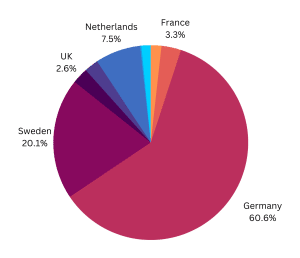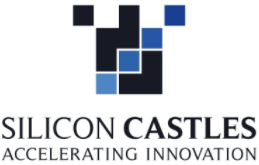How often do you find yourself wondering if a certain skincare product is right for you? For most people, especially those with sensitive skin, choosing a skincare product is a challenge that often results in trial and error, repeatedly going through skincare samples until they arrive at a skincare routine that works.
This is not for lack of skincare products, given that the global skincare market is projected to grow from $100.13 billion in 2021 to $145.82 billion in 2028 – there is clearly a range of choices out there – but rather in making the right choices.
This is where HautAI is trying to make its mark – giving skincare brands and professionals a skin diagnostic tool from a common activity that people use for social media – taking a selfie!
Based in Tallinn, HautAI is an AI skin analysis SaaS product that automates the collection of high-quality skin data from a simple selfie. One of its use cases is helping skincare brands provide skin testing and build interactive product recommendations on e-commerce platforms.
We caught up with Anastasia Georgievskaya, CEO and Co-founder of HautAI, Anastasia walked us through the founding of HautAI, how it collects skin data from selfies and how it ensures that the skin analysis gathered and the product recommendations from the data are accurate. She also spoke about HautAI’s use cases, the challenges in skin diagnostics and skin care and the next steps for HautAI.
How did you get started with Haut.AI?
I founded Haut.AI in 2018 with my business partner Konstantin Kiselev. We were determined to deliver a game-changing software solution for skin analysis. So, when we launched Haut.AI, we didn’t initially focus on market applications or skincare. Our mission was to find differences in skin conditions across demographics, lifestyles, and geographical locations.
The backbone of our software was born from years of clinical software development for Contract Research Organisations (CRO’s) to perform before and after effect measurement. Some of this work evolved in research papers, like the first visual skin ageing biomarker algorithm, called PhotoAgeClock, and neural network architecture for super-accurate segmentation. In the latest research, my single-author study, I combined computer vision and AI to study over 17,000 selfies, calculated 136 skin attributes and described quantitative and qualitative differences in skin ageing biomarkers levels for different demographics. Having applied those parameters to various demographics, I found that skin standards differ greatly across gender, age, and lifestyle. What we consider ‘normal’ skin for a 35-year-old man in Lithuania will not be the same for a 50-year-old woman in Spain. The lack of individuality meant unrealistic consumer expectations and a struggling skincare industry. Konstantin and I were eager to develop a solution – which is how Haut.AI was born.
Now, Haut.AI is a B2B company providing businesses with tools to launch interactive and personalized shopping experiences. Beauty and wellness businesses that work with us receive software solutions their customers can use online, on their smartphones, or at physical locations like retail kiosks and spas. Customers first take a selfie in our software platform, and then we conduct a thorough skin analysis complete with customized recommendations from the brand’s product lines.
Walk us through how Haut.AI collects skin data. Does it really take just a selfie to draw an accurate skin condition and recommend products? How fast is the entire process?
Yes, it does! We trained our software to extract skin data from images and analyse them using Haut.AI SkinMetrics Report software – a combination of natural network algorithms and computer vision methods. The entire process takes less than a minute.
But the simplicity of “just taking a selfie” is only what meets the eye. A lot is going on the back end. When first interacting with Haut.AI Skin SaaS® software, our LIQA® (live image quality assurance) tech kicks in to ensure our algorithms can extract the data from the image. Most quality checks take place on the front end of the application, while only simple adjustment instructions may pop up on the user’s screen. Following image quality assurance, our algorithms extract skin data points for analysis both on the device and backend. Since we are an EU company, we fully comply with GDPR data privacy regulations by anonymizing the user’s skin data. The extracted data points are fed to our database and evaluated amongst thousands of relevant data and metrics recognized by Haut.AI. Our algorithms detect perceived age and perceived gender and use this data in our integrated APIs (such as the weather app Breezometer) to get the most accurate information on the user’s skin. At this point, the first step of Haut.AI’s analysis is finished. Users receive a skin report that evaluates their appearance and skin condition against others of similar demographics and backgrounds. This individual approach allows them to obtain an accurate self-image and set reliable expectations. We are proud of this personalized approach – we don’t want anyone trying (and failing) to achieve the appearance of airbrushed magazine models. We want them to put their skin’s well-being first at a given time. Perfect means something different for everyone.
Some clients, such as skin consultants or wellness professionals, might finish interacting with our software after this initial step, using the data to recommend products. They are skincare experts, and by evaluating their customer’s or patients’ skin reports, they can design the treatment. But most of Haut.AI’s end users aren’t skin professionals but normal skincare shoppers.
Haut.AI offers another step of the analysis for retail applications, which matches the skin report with base skincare ingredients that work best with a given skin type. A woman with dry and more mature skin should search for products rich in antioxidants like resveratrol and hyaluronic acid, while her friend, whose skin tends to be oily, might get an entirely different recommendation. Skincare retailers might also integrate their product ranges into Haut.AI’s software and map their product ingredients with those in Haut.AI’s database so that customers receive ready product recommendations from that retailer’s stock.
Science remains at the core of Haut.AI, allowing our tech to stay highly reliable and accurate. We continuously collaborate with leading scientists and researchers, upgrading our existing and developing new body analytics solutions to incorporate new technologies and exceed industry standards.
What are the metrics you use to test if the skin analysis and the recommended products are accurate?
The accuracy and reliability of our software are integral elements of personalized care. We have trained our algorithms on over 3 million images, and for our test group, we have tested our software predictions against the recommendations of skin experts and dermatologists. This is also why we conduct peer-reviewed research within AI analytics for skin and hair to ensure other experts regularly review our approach. We also perform the ongoing review process every 2 months to confirm the results and predictions are correct. Our system has been constantly updated, with more than 20 new features and user experience updates in the last year alone. Finally, we keep an open dialogue with our clients, who constantly receive feedback from customers on the effectiveness of the protocols recommended to them.
What are the top three use cases of Haut.AI?
The most popular application of Haut.AI’s software is its e-commerce application by retailers and manufacturers. Retailers such as Ulta incorporate our skin analysis software and map their product offering onto our base ingredient recommendations. Shoppers conduct skin analysis via retail kiosks, mobile apps, or web interfaces by simply snapping a selfie. In return, they receive a personalized skin report relevant to their demographic and product recommendations tailored specifically to their skin.
Another use of our software encompasses wellness and spa settings. Professionals use our tools to quickly assess the skin conditions of their patients and choose the best treatments. Since our tools are non-invasive, skin can be evaluated during each visit or even before and after the treatment. Additionally, spa-goers can conduct skin analysis via an online interface before their visit to know what treatments to book.
Born out of academic and tech research, Haut.AI naturally finds its applications in the scientific field. We remain the most accurate AI solution trained to medical-level accuracy for skin analysis. Skin scientists, biotechnologists, and dermatologists use our software to conduct their research across various populations. Since Haut.AI uses a combination of AI and computer vision rather than just computer vision, the data input is automatically analysed to determine skin conditions.
With the ability to perform quality analytics on pictures taken from different angles and in varying light conditions, the data processing time and effort are significantly reduced compared to clinical and lab settings. Scientists and technologists can perform their analysis quicker and with much less labour, getting their research completed and published in a shorter time frame.
What do you think are the top 3 challenges in skin diagnostics and skincare? How is Haut.AI addressing these?
The top three challenges the skincare industry faces today are interconnected: (1) lack of accessibility to skin diagnostics tools that leads to (2) an overwhelming skincare product choice, all while (3) most brands lack products suitable for every consumer’s unique skin type. For example, research shows that 75% of people with melanin-rich skin struggle with hyperpigmentation or scarring. Beauty brands marketing the same products to various skin types put their customers at risk of damaging the skin and worsening their conditions.
Luckily, technology and research have reached the point where they are ready to provide solutions. Haut.AI’s software uses our peer-reviewed scientific research on individual skin analysis. Trained on over 3 million images, our algorithm performs equally well across a range of skin phenotypes. It remains the most advanced, science-backed option for facilitating cosmetic brands’ research and development efforts.
Using our software and data, skincare retailers and brands can learn about their customers’ needs and help them make educated decisions. Since we combine computer vision, neural network processing, and machine learning coupled with live image quality assurance, our software achieves clinical-level accuracy in at-home or spa settings. No specialized equipment or hardware is required, so the user can easily repeat the scan to evaluate the results. The accessibility of skin analytics and personalized product recommendations naturally narrows the choice of products. Wandering between product shelves or clueless scrolling through endless pages of creams and cleansers is the past of skincare. Haut.AI allowed inclusive, educated, and accessible skincare to enter the beauty sector for good.
Since the inception of Haut.AI, what have been its most significant milestones? What about challenges that Haut.AI has overcome or currently overcoming?
The two largest milestones Haut.AI has already achieved were ensuring the market-ready quality of our analyses (which is now done through our live image quality assurance) and finding market applications for our software. When Konstantin and I founded Haut.AI, our primary goal was to develop a cutting-edge solution for accurate skin analysis without requiring specialized equipment. The main challenge was finding the right training data and a perfect combination of neural network processing, computer vision, and machine learning that would allow us to determine skin metrics and skin conditions while remaining sensitive to subtle differences. Having worked with skin scientists and AI experts, we overcame this issue and designed software that performs with clinical-level accuracy across all demographics while using images of a smartphone camera quality, i.e., lower resolution and not perfectly lit.
Having achieved our first milestone, we worked on our next goal – finding market applications for our tooling. We have researched the skincare sector to find that most customers were lost and dissatisfied with the products they use, while many didn’t understand why their skin looked certain. We also discovered that over 10% of unsold skincare, stock ends up in landfill due to manufacturers lacking the bigger picture of their customers’ needs. We realized that this is the gap that Haut.AI’s software can easily fill. We again worked with leading scientists and skin professionals to map skin metrics and conditions with skincare ingredients. Last year, we finally became market-ready and signed up our first big commercial client – Ulta.
The biggest challenge Haut.AI is currently working to overcome is the stigma around AI analysis being inaccurate or not performing similarly well for various skin types. AI technology has developed significantly over the past years, and our software has been trained on diverse data points from the start, achieving 98% accuracy for all demographics. We would not bring a product to the market that wouldn’t be good enough to perform its job. Sadly, some companies did in the past, leading to the public’s reservations and doubts regarding AI analysis quality. Our biggest goal is to expand globally and the best route to do so is by proving that AI can be accurate AND accessible.
Haut.AI is based in Estonia, tell us about the tech landscape in Estonia? What support do you get from government and institutions?
The decision to launch Haut.AI in Estonia was easy, as I have experienced first-hand the country’s vibrant startup sector and embrace of digitalization. Konstantin and I launched Haut.AI one year after Estonia scored first in the EU’s Digital Economy and Society Index – we could not have imagined a better place and time to start a technology business. Interacting with the Estonian digital economy every day allowed us to get into the futuristic mindset of possible new applications and capabilities of AI.
Haut.AI isn’t the only tech start-up within the Estonian sector – it is one of many! And Estonia’s compact size allows startup founders to meet, share ideas, and research with the global market in mind. Although Haut.AI and its Estonian brothers and sisters have expanded into other countries, we’re all proud to be part of this community. We will continue to contribute to our home sector and do our best to support its innovators.
The digital and innovation-driven Estonian public sector is also one of the key drivers for AI and technological development of private startups and businesses. After we launched Haut.AI, Konstantin and I received significant support from Estonian governments We’ve reviewed the European Union Regional Development Fund EAS and Enterprise Estonia RUP grants. The support we received from the EU, the Estonian government, as well as the private and non-profit sector, allowed us to dedicate the first couple of years to conducting research and developing our tools to ensure the accuracy of our tools before we brought them to the market.
- SEO Powered Content & PR Distribution. Get Amplified Today.
- Platoblockchain. Web3 Metaverse Intelligence. Knowledge Amplified. Access Here.
- Source: https://www.eu-startups.com/2023/01/selfies-for-skincare-interview-with-anastasia-georgievskay-ceo-and-co-founder-haut-ai/
- 000
- 1
- 2018
- 2021
- 7
- a
- ability
- About
- academic
- accessibility
- accessible
- accuracy
- accurate
- Achieve
- achieved
- achieving
- across
- activity
- Additionally
- addressing
- Adjustment
- advanced
- Advertisement
- After
- against
- AI
- algorithm
- algorithms
- All
- Allowing
- allows
- alone
- already
- Although
- amongst
- analyse
- analysis
- analytics
- and
- Another
- anyone
- APIs
- app
- Application
- applications
- applied
- approach
- apps
- architecture
- around
- assurance
- attributes
- automates
- automatically
- B2B
- back
- Backbone
- Backend
- backgrounds
- base
- based
- Beauty
- before
- being
- BEST
- Better
- between
- Big
- bigger
- Biggest
- Billion
- biomarker
- body
- book
- born
- brands
- bring
- brothers
- brought
- build
- business
- businesses
- calculated
- called
- camera
- capabilities
- care
- cases
- caught
- ceo
- certain
- challenge
- challenges
- Checks
- choice
- choices
- Choose
- choosing
- clearly
- client
- clients
- Clinical
- Co-founder
- collaborate
- collection
- collects
- combination
- combine
- combined
- commercial
- Common
- community
- Companies
- company
- compared
- complete
- Completed
- computer
- Computer Vision
- condition
- conditions
- Conduct
- conducting
- Confirm
- Consider
- constantly
- consultants
- consumer
- continue
- contract
- contribute
- Core
- could
- countries
- country’s
- Couple
- coupled
- Currently
- Customers
- customized
- cutting-edge
- damaging
- data
- data points
- data privacy
- data processing
- Database
- day
- decision
- decisions
- dedicate
- deliver
- demographic
- Demographics
- described
- Design
- designed
- Determine
- determined
- develop
- developed
- developing
- Development
- device
- dialogue
- DID
- differ
- differences
- different
- digital
- Digital economy
- digitalization
- discovered
- diverse
- Dont
- drivers
- dry
- during
- e-commerce
- e-commerce platforms
- each
- easily
- EC
- economy
- effect
- effectiveness
- effort
- efforts
- elements
- embrace
- encompasses
- Endless
- ends
- enough
- ensure
- ensures
- ensuring
- Enter
- Enterprise
- Entire
- entirely
- equally
- equipment
- error
- especially
- estonia
- EU
- Europa
- European
- european union
- evaluate
- evaluated
- evaluating
- Even
- Every
- every day
- everyone
- evolved
- example
- exceed
- existing
- Expand
- expanded
- expectations
- experience
- experienced
- Experiences
- experts
- extract
- extract the data
- eye
- faces
- facilitating
- FAST
- Features
- Fed
- feedback
- field
- fill
- Finally
- Find
- finding
- finds
- First
- Focus
- following
- found
- Founded
- founders
- founding
- FRAME
- friend
- from
- front
- Front end
- fully
- fund
- futuristic
- gap
- GDPR
- Gender
- geographical
- get
- getting
- given
- Giving
- Global
- global market
- Globally
- goal
- going
- good
- Government
- Governments
- grants
- greatly
- Group
- Grow
- Hair
- Hardware
- having
- help
- helping
- high-quality
- highly
- Home
- How
- HTTPS
- ideas
- image
- images
- in
- inaccurate
- inception
- Inclusive
- incorporate
- individual
- individuality
- industry
- industry standards
- information
- initial
- initially
- innovators
- input
- institutions
- instructions
- integral
- integrate
- integrated
- interacting
- interactive
- interconnected
- Interface
- interfaces
- Interview
- issue
- IT
- Job
- Keep
- Key
- Kicks
- Know
- lab
- Labour
- Lack
- landscape
- largest
- Last
- Last Year
- latest
- launch
- launched
- leading
- Leads
- LEARN
- learning
- levels
- lifestyle
- light
- lines
- Lithuania
- live
- locations
- looked
- Lot
- machine
- machine learning
- magazine
- Main
- make
- Making
- man
- Manufacturers
- many
- map
- mark
- Market
- Marketing
- mature
- means
- Media
- Meet
- Meets
- methods
- Metrics
- might
- milestone
- Milestones
- million
- mind
- Mindset
- minute
- Mission
- Mobile
- mobile-apps
- models
- months
- more
- most
- Most Popular
- Natural
- needs
- network
- Neural
- neural network
- New
- New Features
- New technologies
- next
- NIH
- non-profit
- normal
- offering
- Offers
- ONE
- ongoing
- online
- open
- Option
- Organisations
- Other
- Others
- Overcome
- papers
- parameters
- part
- partner
- past
- patients
- peer-reviewed
- People
- perceived
- perfect
- perform
- performing
- performs
- Personalized
- physical
- picture
- Pictures
- Place
- platform
- Platforms
- plato
- Plato Data Intelligence
- PlatoData
- Point
- points
- pop
- Popular
- populations
- possible
- Predictions
- primary
- privacy
- private
- process
- processing
- Product
- Products
- professionals
- projected
- protocols
- proud
- provide
- providing
- public
- published
- put
- qualitative
- quality
- quantitative
- quicker
- quickly
- range
- reached
- ready
- realized
- receive
- received
- recognized
- recommend
- Recommendation
- recommendations
- recommended
- Reduced
- regarding
- regional
- regularly
- regulations
- relevant
- reliability
- reliable
- remain
- remaining
- remains
- repeat
- REPEATEDLY
- report
- Reports
- required
- research
- research and development
- researchers
- Resolution
- Results
- retail
- retailers
- return
- review
- reviewed
- Rich
- Risk
- Route
- SaaS
- same
- scan
- Scientific Research
- scientists
- Screen
- scrolling
- Search
- sector
- selfie
- sensitive
- set
- settings
- Share
- shelves
- Shoppers
- Shopping
- Short
- should
- Shows
- signed
- significant
- significantly
- similar
- Similarly
- Simple
- simplicity
- simply
- since
- Size
- Skin
- skincare
- smartphone
- smartphones
- So
- Social
- social media
- Society
- Software
- software development
- software platform
- software solution
- solution
- Solutions
- some
- something
- SPA
- Spain
- specialized
- specifically
- standards
- start
- Start-up
- started
- startup
- Startups
- stay
- Step
- Steps
- stock
- Struggle
- Struggling
- Study
- such
- suitable
- support
- system
- tailored
- Take
- takes
- taking
- Tallinn
- tech
- technological
- Technologies
- technologists
- Technology
- test
- Testing
- The
- their
- thousands
- three
- Through
- time
- to
- today
- tool
- tools
- top
- trained
- Training
- treatment
- trial
- types
- understand
- union
- unique
- updated
- Updates
- us
- use
- User
- User Experience
- users
- various
- via
- vibrant
- vision
- walked
- Weather
- web
- Wellness
- What
- which
- while
- WHO
- will
- within
- without
- woman
- wondering
- Work
- worked
- working
- works
- would
- year
- years
- yourself
- zephyrnet












